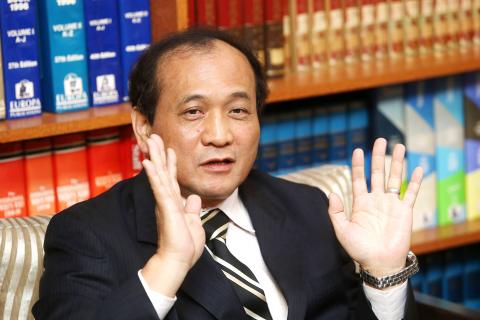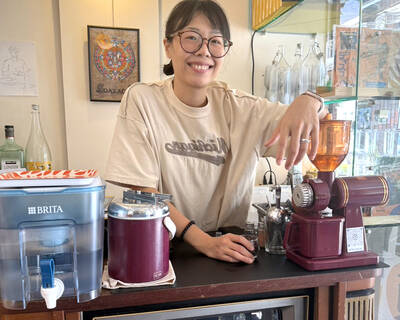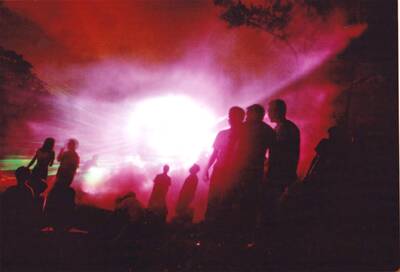Juan Fernando Herrera Ramos: For the people that might not be familiar with this organization, could you explain to us what is the International Cooperation and Development Fund (TaiwanICDF)?
Lee Pai-po (李栢浡): TaiwanICDF is a diplomatic agency that functions in a similar way to USAID from US... We implement ODA [Official Development Assistance] and international cooperation programs, using a bilateral and multilateral approach to implement our international cooperation programs.
Ramos: What is TaiwanICDF role in Taiwan’s foreign policy?

Photo: CNA
Lee: TaiwanICDF and the Ministry of Foreign Affairs (MOFA) share a close relationship and help each other to implement Taiwan’s foreign policy projects. TaiwanICDF and MOFA are independent institutions that work very closely; MOFA provides some of TaiwanICDF budget for technical missions, scholarships and other development programs. All of the programs and activities that TaiwanICDF executes are oriented to consolidate the diplomatic relations between Taiwan, our diplomatic allies and other countries.
Ramos: What is the process TaiwanICDF follows to execute a project?
Lee: Taiwan ICDF uses a methodology called “Project Cycle, [which] usually starts after a country requests for assistance in a certain area through our embassy. The embassy then will report the said request back to TaiwanICDF, so that we can proceed to evaluate it and make a feasibility study. Once the feasibility study is completed, the results will be sent back to MOFA to let them know whether the project is feasible or not, and at that point MOFA will make the final decision.
Ramos: What do you consider to be TaiwanICDF’s biggest challenge?
Lee: I think that when we talk about the implementation of a project, one of our biggest challenges would be the pressure from China, which is something we always take in account when making our political cons.
The second biggest challenge that we usually face is the sustainability of the projects. When we execute a project in developing countries one of the key issues is human capital, because even if we can provide capacity building or technology to the people in those countries, we have seen that in some cases it becomes a problem for them to take over the projects. Some of the people in those countries have been able to take over very well, but some cannot.
The third biggest challenge comes down to financial issues, some of these projects can take up to four to five years to be completely operational, but when it is time for the local government or local organization to take over, they have constraints with budget support or manpower, and this leads to the suspension of the project.
When the projects start to be implemented, the majority of the budget is covered by ICDF and MOFA, with the local government only providing a small amount of the costs, but when the project is completed and Taiwan withdraws, the cooperating local government has to take over the whole operation. At this point the funding needs to come completely from the local government and we have had some instances where the funding severely declines and is very difficult for the program to survive.
Ramos: Could you mention some of the projects in which TaiwanICDF is currently involved?
Lee: Currently, the amount of countries in which we have a technical mission on the ground is 26, but overall we are cooperating with 46 countries. That is because we also hold workshops and offer scholarships to people from countries that do not have a diplomatic relationship with Taiwan.
The main areas of assistance that we focus on are agriculture, public health, education, environment and ICT [information and communication technology], so all of our projects are focused on those areas.
Ramos: How is TaiwanICDF dealing with the Chinese pressure in the international Sphere?
Lee: For countries that are our diplomatic allies there is no pressure, but in non-diplomatic allied countries there is a big pressure coming from China, so we think of ways to collaborate with them through international organizations or international non-governmental organization to overcome this situation.
If the programs are executed through IGOs or INGOs this can reduce the sensitivity in the implementation of projects of humanitarian assistance, natural disasters or man-made disasters.
Another strategy that we use is to make “segmentation” with China. For instance, China is very focused on infrastructure development in Africa, Asia and Latin America, so instead of competing for infrastructure projects, we try to develop the soft power: agriculture, ICT, education.
If they develop hard power we develop soft power to reduce their pressure and it works very well.
Ramos: What are your expectations for TaiwanICDF in the next 5 years?
Lee: In the future I would like to focus on the following aspects: The first point and most important one should be the human capital development. We will try to cultivate a young generation to have qualified man-power in our organization. The young people cultivation is very important so that they can take over all the programs and projects we execute, to keep our foreign policy in a good direction.
The second point is to expand, since China has become one of the largest economies in the world, we can’t compete with them economically, but we must continue to strengthen the relationship with our 17 remaining allies. We must also try to regain some of the allies that have already switched ties, even if there is just a small possibility like with El Salvador. But since it is not 100 percent sure that our allies will not switch ties to China, we still need to expand our scale of international cooperation through the IGOs and INGOs with the purpose of letting the global community have the idea that Taiwan is an independent country and that we still exist in the global community, that we have not disappeared.
The third point is to increase our cooperation budget for official development assistance, currently we have about US$340 million (NT$10.5 billion) available to be used in projects around the world so it is very hard to compete with China who has a vast amount of financial resources, but we must try to convince our legislators to increase this budget every year. It is important to mention that this money is not given in cash to other countries. We use it for technical assistance and capacity building, [so as] to avoid any corruption issues and try to use our funding effectively and efficiently.
The final one is for TaiwanICDF to collaborate with government agencies to participate in international organizations activities. Our participation has decreased in the international sphere because of the attitude the Chinese government has taken after the 2016 elections in Taiwan. There are many worldwide organizations that we would like to be a part of because not being a member is very inconvenient for Taiwan. That is why we will strive for participation in international organizations and conferences.
Ramos: Is there anything else that you would like our readers to know?
Lee: I think is important that people understand why these kinds of projects need to continue, TaiwanICDF has a mandate and a mission to collaborate with MOFA and we will continue to carry it on with dedication.

Cheng Ching-hsiang (鄭青祥) turned a small triangle of concrete jammed between two old shops into a cool little bar called 9dimension. In front of the shop, a steampunk-like structure was welded by himself to serve as a booth where he prepares cocktails. “Yancheng used to be just old people,” he says, “but now young people are coming and creating the New Yancheng.” Around the corner, Yu Hsiu-jao (饒毓琇), opened Tiny Cafe. True to its name, it is the size of a cupboard and serves cold-brewed coffee. “Small shops are so special and have personality,” she says, “people come to Yancheng to find such treasures.” She

The low voter turnout for the referendum on Aug. 23 shows that many Taiwanese are apathetic about nuclear energy, but there are long-term energy stakes involved that the public needs to grasp Taiwan faces an energy trilemma: soaring AI-driven demand, pressure to cut carbon and reliance on fragile fuel imports. But the nuclear referendum on Aug. 23 showed how little this registered with voters, many of whom neither see the long game nor grasp the stakes. Volunteer referendum worker Vivian Chen (陳薇安) put it bluntly: “I’ve seen many people asking what they’re voting for when they arrive to vote. They cast their vote without even doing any research.” Imagine Taiwanese voters invited to a poker table. The bet looked simple — yes or no — yet most never showed. More than two-thirds of those

In July of 1995, a group of local DJs began posting an event flyer around Taipei. It was cheaply photocopied and nearly all in English, with a hand-drawn map on the back and, on the front, a big red hand print alongside one prominent line of text, “Finally… THE PARTY.” The map led to a remote floodplain in Taipei County (now New Taipei City) just across the Tamsui River from Taipei. The organizers got permission from no one. They just drove up in a blue Taiwanese pickup truck, set up a generator, two speakers, two turntables and a mixer. They

Former Chinese Nationalist Party (KMT) chairwoman Hung Hsiu-chu’s (洪秀柱) attendance at the Chinese Communist Party’s (CPP) “Chinese People’s War of Resistance Against Japanese Aggression and the World Anti-Fascist War” parade in Beijing is infuriating, embarrassing and insulting to nearly everyone in Taiwan, and Taiwan’s friends and allies. She is also ripping off bandages and pouring salt into old wounds. In the process she managed to tie both the KMT and the Democratic Progressive Party (DPP) into uncomfortable knots. The KMT continues to honor their heroic fighters, who defended China against the invading Japanese Empire, which inflicted unimaginable horrors on the